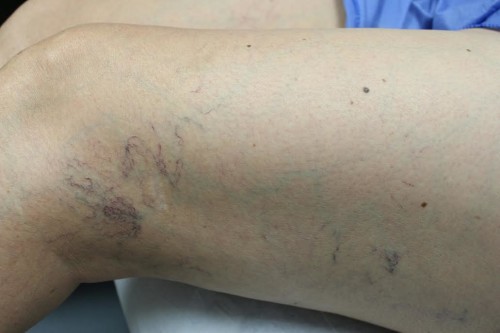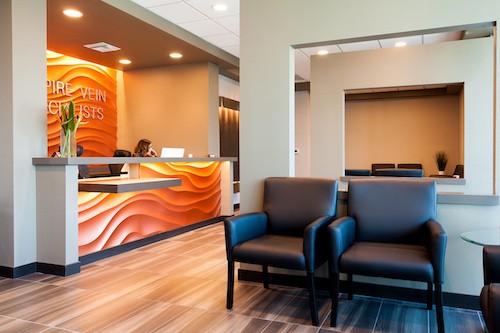
Varicose veins and spider veins affect 30 million U.S. adults at a cost of over $1 billion per year in direct healthcare expenses[1] and currently, those numbers are increasing rapidly[2]. There are numerous reasons why varicose veins occur, some of which you can modify while others cannot be changed. Here we discuss some of the most common risk factors for varicose veins and spider veins.
Genetics
Your genes play a big part in whether you will develop varicose veins. To date, scientists have identified 30 genes that contribute to the risk for varicose veins, with the strongest association being a gene that regulates blood pressure[1]. Overall, genetic alterations account for more than 60% of the difference in susceptibility to varicose veins from one person to the next[2].
If both of your parents have varicose veins you have a 90% chance of developing varicose veins at some time in your life[3]. If one of your parents is affected your risk is 25% if you are male and 62% if you are female[3]. When neither parent is affected the risk for the child is 20%[3].
Standing Occupations
Occupations that require prolonged standing are associated with significantly higher rates of varicose veins. Standing still increases pressure in the veins and decreases the pumping effects of calf muscles in assisting return blood flow and reducing the pooling of blood in the legs[2].
A standing job that involves a lot of walking may be less likely to cause varicose veins since walking activates the calf muscle pump that helps push the blood and reduce the pooling of blood[4]. One study found that venous insufficiency among medical operating room personnel and laundry workers, occupations that require a lot of standing with little walking, was as high as 76%[3].
However, if the valves are faulty, walking can have the opposite effect. As activity increases blood flow increases, but insufficient valves result in greater reflux and pooling of blood[4].
Age
As you age your risk for varicose and spider veins increases. In the general population around 30% of women and 15% of men are affected, but by the age of 70 prevalence increases to 77% in women and 57% in men[2].
With age the gender disparity in varicose and spider veins decreases and the risk for abdominal varicosities increases[3]. Women who use hormone replacement therapy may place themselves at greater risk since estrogen makes blood vessel walls more expandable leading to reflux of blood and distention of veins[1].
Gender

Most studies find that women are more prone to varicose veins and spider veins than men. Some experts suggest that these findings may be skewed citing the fact that more women tend to participate in varicose vein studies[3]. This disparity is thought to be due to greater concern among women about the cosmetic effects[3] or more awareness about the condition, in general[1].
However, men tend to develop advanced stages of varicose veins at a higher rate than women and this is true even when age is factored out[3].
Diet and Nutrition
Low-fiber diets, which are common in the U.S., lead to chronic constipation (having a bowel movement less frequently than once per day). Straining to evacuate increases pressure in the abdomen and when this happens on a regular basis, can lead to vein dilation[3]. Also, the bowel can become distended, compressing the abdominal veins, and reducing blood flow[3]. Constipation significantly increases the risk for varicosities in the abdomen, in particular[1].
Additionally, Western diets tend to be low in vitamin E, which leads to increased risk for blood clotting and changes in blood vessel walls that can cause varicose and spider veins[3].
Obesity
Having a body mass index (BMI) of more than 20 almost triples your risk for varicose veins[5]. Increased abdominal pressure associated with obesity results in decreased return blood flow from the legs and, therefore, increased pressure in the veins.
Additionally, obese individuals tend to have lower levels of physical activity, which means less contraction of calf muscles – an important part of the normal mechanism that helps push the blood back to the heart[6]. Studies show that obesity and lack of physical activity are more associated with increased risk for varicose veins in women than men[3].
Pregnancy
Women who have had two or more pregnancies have a 20% to 30% increased risk for developing varicose veins[3]. When varicosities appear early in a pregnancy, high levels of progesterone are thought to play a role. This hormone promotes the relaxation of muscles lining the veins[3].
Deep Vein Thrombosis
If you were previously diagnosed with a blood clot in your leg, known as deep vein thrombosis, your risk for developing varicose and spider veins is significantly increased due to the increased pressure and stress on the veins from the occlusion of venous blood flow[5].
Height
The taller you are the more work your body has to do to push blood back to your heart from your lower body, making you more susceptible to problems such as blood pooling and reflux that can lead to varicose and spider veins[1].
VenaSeal® Outpatient Vein Treatment

To discuss your risk factors for varicose and spider veins and learn about simple procedures that can resolve your varicose vein problems schedule a free consultation at Empire Vein Specialists. Since varicose veins run in families, we often treat multiple family members and generations within a family and encourage families to attend consultations together. All of our physicians are board-certified vascular surgeons who specialize in helping people like you. Empire Vein Specialists is the top provider of VenaSeal®, the leading outpatient varicose vein treatment, in the USA. To schedule a free consultation, please call 1-800-827-4267 (1-800-827-4267) today.
References
- Clinical and Genetic Determinants of Varicose Veins. Circulation, 2018. 138(25): p. 2869-2880
https://pubmed.ncbi.nlm.nih.gov/30566020/ - Biomolecular mechanisms in varicose veins development. Ann Vasc Surg, 2015. 29(2): p. 377-84
https://pubmed.ncbi.nlm.nih.gov/25449990/ - The influence of environmental factors in chronic venous insufficiency. Angiology, 2003. 54 Suppl 1: p. S19-31
https://pubmed.ncbi.nlm.nih.gov/12934754/ - Standing at work and varicose veins. Scand J Work Environ Health, 2000. 26(5): p. 414-20
https://pubmed.ncbi.nlm.nih.gov/11103840/ - Epidemiology and risk factors for varicose veins among older people: cross-sectional population study in the UK. Phlebology, 2010. 25(5): p. 236-40
https://pubmed.ncbi.nlm.nih.gov/20870870/ - Obesity and lower limb venous disease – The epidemic of phlebesity. Phlebology, 2017. 32(4): p. 227-233
https://pubmed.ncbi.nlm.nih.gov/27178403/